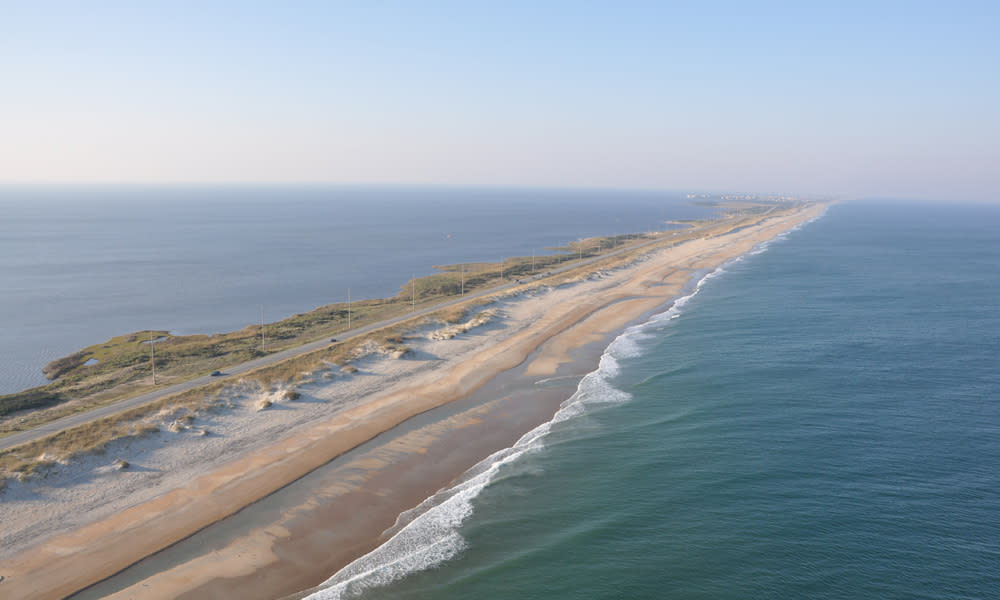
FIRSTS:
- The first English child born in the New World was Virginia Dare on August 18, 1587, at Fort Raleigh on Roanoke Island. Virginia Dare and the colonists of Fort Raleigh would become known as “The Lost Colony” … their disappearance still an unsolved mystery.
- In 1902, Reginald Fessenden made the first application of a successful, commercially – adaptable technique of radio communications in North America and perhaps the entire world. His experiments and invention of the wireless telegraph and telephone were made between a station located on Roanoke Island and a section station in Buxton. After leaving North Carolina, Fessenden went on to establish the first commercial Trans-Atlantic two-way radio-telegraph service in 1905, two years before the world renowned Marconi. Then, in 1906, Fessenden’s station in Massachusetts broadcasted the world’s first radio program for entertainment.
- On December 17, 1903, two brothers, Orville and Wilbur Wright, made the first successful flights in motor-driven, heavier-than-air machines, thus ushering in the age of human flight. These historical flights took place on the sloping sands of what is now known as Big Kill Devil Hill, located just south of Kitty Hawk.
- The Cape Hatteras National Seashore, encompassing more than 28,000 acres along the Outer Banks, was the first to be established by our government. The purpose was to preserve this beautiful shoreline for the enjoyment of future generations.
- Richard Etheridge became America's first black lifesaving station keeper with his appointment to the Pea Island post in 1880. He served as keeper until his death in 1900. He was a former soldier and surfman.
FACTS:
- Dare County covers 800 square miles, comprising 391 square miles of land and 409 square miles of water. This means over half of Dare County is water, and 80% will never be developed because its in some kind of conservation area, such as a National Park, U.S. Wildlife Refuge, state park or shoreline.
- The Cape Hatteras Lighthouse, which stands at 208-feet, is the tallest brick lighthouse in the United States.
- “The Lost Colony,” performed at the Waterside Theater on Roanoke Island, is the oldest-running outdoor symphonic drama in the country.
- The War Between the States brought several battles to the Outer Banks. At Hatteras Inlet (August 1861), at Chicamacomico (October 1861) and on Roanoke Island (February 1862), the Federals won their first victories of the war and established control over the Outer Banks. The inhabitants were not strongly attached to the Southern cause, and many took the oath of allegiance to the United States.
- The Nags Head Woods Preserve is considered one of the best remaining examples of a mid-Atlantic maritime forest, according to the Nature Conservancy organization. The habitat is made up of 640 acres of protected wetland, dune and hardwood forest and is a national natural landmark.
- On November 22, 1718, Edward Teach, better known as Blackbeard the pirate, was slain by Lt. Robert Maynard of the Royal Navy, in Ocracoke Inlet.
- The oldest and shortest lighthouse in North Carolina is the Ocracoke Lighthouse. It’s the second oldest operational lighthouse in the United States.
- More than 365 species of birds have been identified at the Pea Island National Wildlife Refuge, located on the north end of Hatteras Island. Bird list boasts more than 365 species; wildlife list has 25 species of mammals, 24 species of reptiles, and 5 species (low number due to salt environment) of amphibians.
- In 1874, the U.S. Lifesaving Service was begun by building a chain of seven lifesaving stations along the Outer Banks, at the points of greatest danger to ocean going vessels. The U.S. Lifesaving Service was the forerunner to the U.S. Coast Guard. The lifesaving stations, working in conjunction with the several lighthouses located along the Outer Banks, helped to save and rescue many vessels as they passed through the “Graveyard of the Atlantic.”
- According to the International Gamefish Association, the Outer Banks and the Virgin Islands are the most likely places to catch Atlantic Blue Marlin weighing more than 1,000 pounds.
- Jockey’s Ridge State Park, located in Nags Head, is the home of the highest sand dune on the East Coast with peaks at more than 90 fee
About The Outer Banks
About The Outer Banks The Outer Banks of North Carolina is a chain of barrier islands midway on the Atlantic Seaboard. The Outer Banks Visitors Bureau is a public authority and the lead marketing and promotional agency for Dare County's Outer Banks. The Bureau’s web site is www.outerbanks.org.

